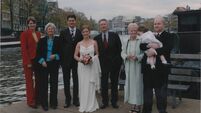‘Blazerati’ must pull up a stool and talk to the drinking man
But they are not overly despondent. They’re old hands. They’ve been through the drill before. The result does not ruin their day out. They had a few drinks in Dublin before the game, and a few after it. There is no particular rush home.
They stop in Drogheda. And because they know a place that opens after hours in Dundalk, they stop there too. The craic is good.
But they eventually have to face the prospect of Monday morning. There isn’t as much chat in the car when they drive through customs and cross into the dark north.
Both heads are beginning to drop as they near home. Suddenly the car veers across the middle of the road. Startled by the incident, Sean shouts: “For God’s sake, Joe, keep her between the ditches.”
An unperturbed Joe calmly replies: “I don’t know why you’re yelling at me, I’m not the one who’s driving.”
I heard that yarn years ago and it captures many of the real life adventures that used to take place on the roads to and from hostelries between Dublin and home.
In those days if the ordinary drinking man wanted to see the game, he had to go to the ground. Live television was not an option.
Yet even then, there was no guarantee that the drinking man who hopped into the back of a car on a Sunday morning would actually make it through the turnstiles. When drink was cheaper, many solid characters found it difficult to prize themselves away from the bar.
A tale from my home town explains the dilemma that would confront the drinking man. In the 1950s a half ‘un of whiskey was two and six in the north and about two shillings in the south, a substantial saving.
When a convoy of Maghera men stopped in Dundalk on their way to Dublin they couldn’t drag one particular individual out of the pub.
Heeling glasses of whiskey into him like there was no tomorrow, he explained his reluctance to leave: “I’ve nearly saved a pound already,” he told them.
In the 1940s, I had relations who would go to watch Derry in Clones. They would invariably stop in Monaghan, where they would invariably stay stopped. The reason: “Aren’t we better off spending our money here than giving it to that crowd.” The match would be ‘watched’ on the radio.
Not much has changed in the intervening years.
There is still a massive disconnection between the ordinary drinking man and ‘that crowd’, the GAA hierarchy that sit on committees and set ticket prices.
Consider briefly your stereotypical GAA official. A professional tea-drinker. A ham sandwich supremo.
Now, consider the men who sit in bars watching Championship games. We are dealing with two different species.
During the recession the gap between the men has become particularly pronounced. The GAA’s failure to appreciate the purse and psyche of the ordinary man has been depressing.
In this year’s Ulster championship, it was easy to ascertain the problem. Despite the poor attendance at most games, the seated areas were crammed.
The empty spaces were on the terraces.
Bear in mind, that seated tickets are the most expensive. But how can the priciest tickets be the most popular? The answer lies in the two distinct sets of supporters that follow games.
The fans who pay €25 are actually impervious to price. They would pay double. Boom or bust, they’ll be at the match.
The ritual is written into their DNA. Up. Tea. Mass. Home. Dinner. Tea. Pack boot of car with tea and sandwiches. Leave at 11am.
The man who is happy to stay in the pub and comes into the ground for the last 10 minutes of the minor match is a different animal. He is extremely sensitive to price.
But look at how the Ulster Council reduced its prices for next Sunday’s final. Seated tickets were ‘slashed’ from €30 to €27 and terrace tickets went down from €18 to €15.
For reasons known only to themselves, Ulster’s ‘Blazerati’ reckon the same principles apply to all GAA fans.
The Gerry Arthurs Stand would be packed to the brim if they increased prices to €50.
Terraces tickets are different. They should be €10 for everyone — students, senior citizens and the most penny conscious punter of the lot — the ordinary drinking man.
The fact is the GAA got away with charging scandalous prices when bricklayers were earning €1,000 a week. Those days are gone.
The big screen in the pub is a cheaper, easier option. The armchair and a fridge full of beer is even cheaper again.
How can GAA officialdom draw these fans out of their bars and homes and through the turnstiles? For starters, they might consider talking to them. In business, it’s called market research.
Given that the GAA now behaves no differently to any other commercial organisation, they should think about using this tool. The acres of terraced concrete on display in this year’s championship would suggest that new methods are required.
p.heaney@irishnews.com












